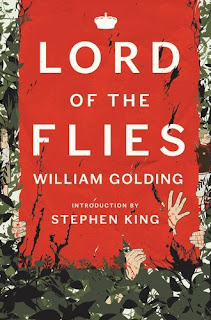 by William Golding
by William Golding
1954 / 304 pages
this edition with introduction by Stephen King published 2011
First off: a caution about the author of the introduction. I would not recommend any book by this author. Stephen King's horror novels fail to do one thing that this novel does very well, and that is to make violence
truly horrifying.
As a study novel for many English teachers, this story is so well known that it's hard to say anything really new about it. I even read an article once, when the television "reality" series
Survivor began, that compared it to this novel.
Actually, that's a good place to start in talking about Golding's story.
Survivor fails as art because it succeeds as entertainment (in the worst way). It makes the backstabbing treachery required to win a million dollars (by getting the others voted "off the island") amusing and flattering to our self-righteous sense of superiority to its crudely cunning contestants. Golding, though, shows us that even "the best laid plans gang aft agley" (as Robert Burns put it). In other words, while
Survivor (and many daytime talk shows) enable us to compare ourselves (favorably, of course) to the so-called "trailer park trash" of our world and think like the Pharisee in Christ's parable that we are "not like that publican over there,"
Lord of the Flies shows us that "there, but for the grace of God, go I."
Not that Golding was a Christian. One of his novels depicts the wanderings and conflicts of a group of Neanderthals, and the few seemingly Biblical references in
this novel are double-edged. For instance, one character seems Christ-like in his compassion and meekness, and cries out something about "a body on a hill" - a seeming reference to the Crucifixion - but that character also seens to hear the voice of "the lord of the flies" (a literal translation of
Beelzebul, a Biblical name for the devil) in the midst of what seem to be epileptic fits.
So... Golding is not writing from a Christian perspective; however, Christians will still find much worthy of consideration in this story. Golding had served in World War II, and had plenty of evidence of man's inhumanity to man. This hard-won insight into man's innate bent toward evil enabled him to see what Reformed Christians call total depravity.
The novel begins with the crash landing of a plane on a desert island. The boys inside are being evacuated from England due to the threat of a nuclear war. How these young boys set up their own new society without any adult supervision is the point of the story. In the early Christian church, Pelagius believed that our sinful behaviour was learned rather than inborn. If so, these boys should have an immense advantage over the adults whose war threatens to destroy civilization, but do they?
If, on the other hand, we are conceived and born in sin, the boys' reconstructed society should show man's evil on two levels. In the first place, various boys or groups of boys highlight various aspects of man's nature - his reason, his spiritual side, his common sense, his desire for power. The Greek philosopher Plato believed that our main problem was our inability to balance these various parts of our personality, and the boys' society shows exactly how the best sides of our nature are overwhelmed by the worst in us.
Secondly, various boys or groups of boys remind us as we read of groups running amok within a dysfunctional society like the military, intelligence agencies, government, mystics, and scientists. While various ideologies tend to idolize certain kinds of people, the Christian understanding of total depravity would predict that each group has its own weaknesses, temptations, and sins. Golding indeed shows how there are no "good guys" on the island (just as King David, the man after God's own heart, was yet guilty of many sins). The one who gets closest, sadly, has the least influence.
The novel does not end terribly hopefully. Even Golding himself, in an interview, revealed that one of the characters that people tend to trust the most in the novel got everything completely wrong. So... what hope does the novel leave Christians with? The beauty of the novel is that one of the characters, the one through whose eyes we have viewed most of the story, has gained enough insight into himself and the other boys to grieve the evil they have done, and most importantly, to stop making excuses for it. The novel challenges us, with the added insight of God's word, to do the same for ourselves.
You can pick up a copy at
Amazon.com here and
Amazon.ca here.



